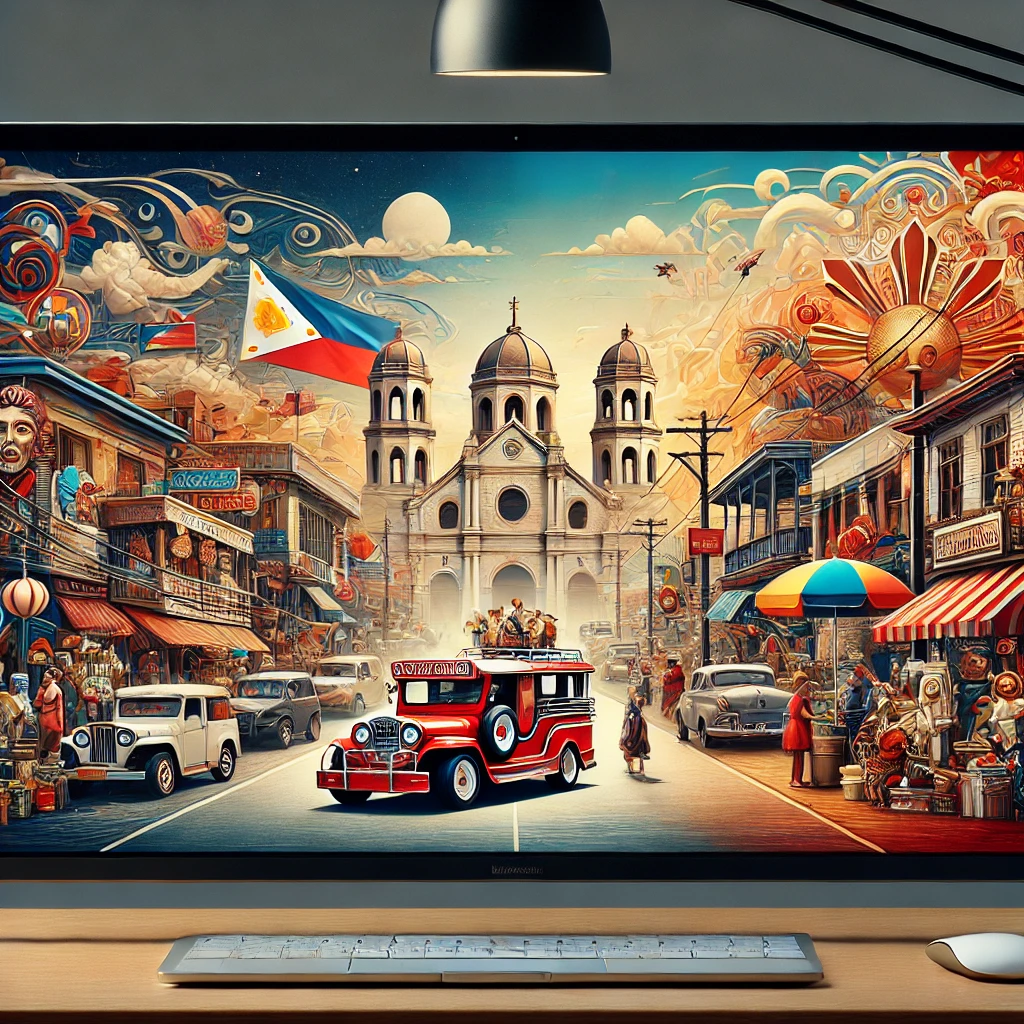Hey there, kabayan! Ready to take a wild ride through the vibrant and ever-evolving world of Filipino slang? Buckle up, because we’re about to embark on a linguistic adventure that’ll make your lola’s dentures drop! Filipino slang, or “Pinoy lingo” as we affectionately call it, is more than just a collection of cool words – it’s a window into the soul of our culture, values, and the unique way we see the world. From the bustling streets of Manila to the serene beaches of Palawan, our slang tells a story of who we are as a people. So, let’s dive in and explore how our everyday lingo reflects the heart and humor of the Filipino spirit!
The Evolution of Filipino Slang: From Jeepney Jargon to TikTok Talk
A Brief History Lesson (Don’t Worry, It’s Fun!)
Alright, class, put away your smartphones for a hot minute (just kidding, you’ll need them later) as we take a quick trip down memory lane. Filipino slang didn’t just pop up overnight like a surprise pimple before a big date. It’s been evolving faster than our politicians’ promises during election season!
Back in the day, when our grandparents were young and hip (yes, they were once!), Filipino slang was largely influenced by our colonial past. Spanish and English words got mixed into our local languages faster than you can say “Taglish.” Fast forward to the post-war era, and we see the rise of what we might call “classic” Filipino slang. Words like “groovy” and “cool” got Pinoy makeovers, giving birth to terms like “astig” and “poging-pogi.”
But wait, there’s more! The advent of technology and social media has turbo-charged our slang evolution. Suddenly, we went from simple abbreviations like “OMG” to full-blown internet speak that would make our English teachers faint. “Lodi” (idol), “werpa” (power), and “shookt” (shocked) became part of our daily vocabulary faster than you can double-tap an Instagram post.
From Street Smart to Tech Savvy
Let’s break it down even further, shall we? Here’s a neat little table showing how Filipino slang has evolved over the decades:
| Decade | Influential Factors | Sample Slang | English Translation |
|---|---|---|---|
| 1950s-60s | Post-war American influence | “Ipis” | Cool/Awesome |
| 1970s-80s | Local pop culture | “Bongga” | Fabulous/Amazing |
| 1990s-2000s | TV and radio | “Chika” | Gossip |
| 2010s-2020s | Social media and internet | “Jowa” | Boyfriend/Girlfriend |
As you can see, our slang has come a long way from the days of “groovy” to the era of “slay.” It’s like watching a linguistic telenovela unfold before our very eyes – dramatic, unpredictable, and utterly captivating!
The Cultural Melting Pot: How Filipino Values Spice Up Our Slang
Family First, Even in Our Words
Now, let’s get to the meat and potatoes (or should I say, the adobo and rice) of our discussion. Filipino values are as deeply ingrained in our slang as rice is in our daily diet. And speaking of diet, have you noticed how many of our slang terms are food-related? It’s like we can’t help but mix our love for eating with our love for talking!
Take the term “lambing,” for instance. This word, which loosely translates to “sweetness” or “affection,” is quintessentially Filipino. It encapsulates our deep-rooted value of family closeness and affection. When we say someone is “malambing,” we’re not just saying they’re affectionate – we’re painting a picture of the warm, loving relationships that are the cornerstone of Filipino families.
Or how about “pasalubong”? This concept of bringing gifts when returning from a trip is so ingrained in our culture that we’ve turned it into a verb. “Pasalubong-an mo naman ako!” isn’t just a request for a souvenir – it’s an expression of thoughtfulness and the importance we place on remembering our loved ones, even when we’re apart.
Respect and Hierarchy: Not Just for Titos and Titas
Another value that’s heavily reflected in our slang is respect for elders and authority. We’ve got a whole arsenal of terms to address people based on their age and status. “Kuya” and “Ate” aren’t just for actual siblings – they’re a way to show respect to anyone older than us, even if it’s just by a year or two. And don’t even get me started on the complex system of “po” and “opo” – it’s like verbal gymnastics for politeness!
But here’s where it gets interesting: our slang also shows how we navigate and sometimes subvert these hierarchies. Take the term “mamser” – a cheeky combination of “ma’am” and “sir” that we use when we’re not sure how to address someone. It’s our linguistic way of saying, “I respect you, but I’m also keeping things casual.” Smooth, right?
The Humor Factor: Laughing Our Way Through Life
Puns, Wordplay, and Double Meanings Galore
If there’s one thing Filipinos are known for (besides our legendary hospitality and our ability to find Jollibee anywhere in the world), it’s our sense of humor. And boy, does it show in our slang! We love puns, wordplay, and double meanings so much, it’s like we’re constantly hosting a linguistic comedy show.
Take the term “kilig,” for example. This untranslatable word that describes the giddy feeling of romantic excitement has spawned a whole family of related terms. “Kinikilig,” “kilig to the bones,” “kilig much?” – we’ve turned this feeling into a full-blown language of its own. It’s like we’re so in love with love, we had to invent new ways to talk about it!
Or how about “beshie”? This term of endearment for a best friend is a perfect example of how we Filipinize English words. We took “bestie,” gave it a Pinoy twist, and voila! A new slang term was born. It’s like linguistic alchemy, and we’re all here for it.
Self-Deprecating Humor: Our Secret Weapon
But perhaps the most Filipino aspect of our slang humor is our ability to laugh at ourselves. We’ve got a treasure trove of self-deprecating terms that show we don’t take ourselves too seriously. “Kalbo” (bald) becomes “folically challenged.” “Pandak” (short) transforms into “vertically challenged.” It’s like we’re turning our insecurities into stand-up comedy material!
Here’s a fun table of some of our favorite self-deprecating slang terms:
| Filipino Slang | Literal Meaning | Humorous Meaning |
|---|---|---|
| Petmalu | Malupet (Awesome) backwards | Extremely awesome |
| Lodi | Idol backwards | Someone admirable |
| Awra | Aura (mispronounced) | Confidence, style |
| Charot | Joke (from “charot-charotan”) | Just kidding |
These terms show that we Filipinos have mastered the art of not taking ourselves too seriously. We can throw shade and compliments in the same breath, all while keeping things light and funny. It’s a linguistic superpower, I tell you!
The Digital Revolution: How Technology is Shaping Filipino Slang
From Text to TikTok: The New Frontier of Pinoy Lingo
Alright, time to dive into the digital deep end! If you thought your lola’s slang was hard to understand, wait till you hear what the kids are saying these days. The internet and social media have turned Filipino slang into a rapidly evolving creature that would make Darwin’s head spin.
Remember the days of “text speak” when we had to cram our messages into 160 characters? That gave birth to classics like “g” for “go” and “hm” for “how much.” But now, with smartphones and unlimited data plans (thank you, telco gods!), we’ve entered a whole new era of digital slang.
Social media platforms like Facebook, Twitter, and especially TikTok have become breeding grounds for new slang terms. “Sana all” (I wish this applied to everyone) spread faster than fake news during election season. “Skl” (share ko lang – just sharing) became the go-to prefix for humble brags. And don’t even get me started on “pomsem” (promise) – it’s like we’re speaking in code, and I’m here for it!
The Meme-ification of Language
But it’s not just about new words – it’s about new ways of communicating. Memes have become a language of their own, with classic Filipino memes spawning slang terms that make absolutely no sense out of context. Remember “Ang pogi ko talaga, ‘di ba? – Edi wow!” (I’m so handsome, right? – Wow, good for you!)? That “Edi wow” became the ultimate sarcastic response faster than you can say “viral.”
Here’s a quick rundown of some popular Filipino internet slang and their origins:
| Slang Term | Meaning | Origin |
|---|---|---|
| Dasurv | Deserved | Internet speak |
| Naur | No | TikTok |
| Sheesh | Expression of awe | Social media |
| Gagi | Playful expression | Filipino “gago” (stupid) |
It’s like we’re creating a whole new language, one meme at a time. Linguists of the future are going to have a field day with this!
The Dark Side: When Slang Reflects Societal Issues
Not All Fun and Games
Now, let’s get a bit serious for a moment (don’t worry, I promise we’ll get back to the fun stuff soon). As much as Filipino slang is a celebration of our culture and humor, it can also reflect some of the less savory aspects of our society. Like that one relative who always brings up awkward topics at family gatherings, some of our slang terms shine a light on issues we’d rather not talk about.
Take, for example, the prevalence of colorism in our society. Terms like “kutis mayaman” (rich people’s complexion) to describe fair skin, or “nognog” as a derogatory term for darker-skinned individuals, reflect deep-seated biases that we’re still grappling with as a society. It’s like our language is holding up a mirror to our collective psyche, and sometimes, we don’t like what we see.
Or consider how some of our slang terms reinforce gender stereotypes. “Macho-gwapito” for an overly masculine man, or “kikay” for a girly-girl – these terms, while often used affectionately, can also box people into rigid gender roles faster than you can say “toxic masculinity.”
The Power of Words: Reclaiming and Redefining
But here’s the thing about language – it’s not set in stone. Just as problematic terms can arise, so too can we choose to reclaim and redefine words. The LGBTQ+ community in the Philippines has been particularly adept at this, turning once-derogatory terms into expressions of pride and identity. “Bakla,” once used as an insult, is now worn as a badge of honor by many. It’s like linguistic judo – using the weight of negative words against themselves.
And let’s not forget how younger generations are challenging these problematic terms. “Moreno/morena” is making a comeback as a positive description for darker skin tones. Body-positive movements are reclaiming terms like “mataba” (fat) and stripping them of their negative connotations. It’s like watching a linguistic revolution in real-time, and it’s absolutely fascinating.
The Global Filipino: How Our Slang Travels the World
From Balikbayan Boxes to Viral Videos
Now, let’s zoom out and look at the bigger picture. Filipino slang isn’t just staying within our 7,641 islands (at low tide, of course). Thanks to our penchant for working abroad and the magic of the internet, our slang is going global faster than you can say “It’s more fun in the Philippines!”
The Filipino diaspora has been spreading our linguistic quirks far and wide for decades. “Trabaho” (work) has found its way into the vocabularies of non-Filipino coworkers from Hong Kong to Helsinki. “Pasalubong” is being explained in broken English in airports around the world. It’s like we’re linguistic Johnny Appleseeds, planting little bits of Pinoy culture wherever we go.
But it’s not just about physical travel anymore. Social media has turned Filipino slang into a global phenomenon. Remember when “Manila” turned into “Manileugh” on TikTok? Or how “naurrr” (a Pinoy twist on “no”) started popping up in comments sections worldwide? It’s like our slang has gotten a passport and is now jet-setting around the digital globe.
The Boomerang Effect: When Global Slang Comes Home
Here’s where it gets really interesting. As our slang travels the world, it often comes back to us changed, like that tito who went abroad and came back with a weird accent. Global internet culture is now influencing Filipino slang just as much as we’re influencing it.
Take “slay,” for example. This term, which originated in African American Vernacular English (AAVE), has been embraced by Filipino youth with such enthusiasm, you’d think we invented it ourselves. We’ve Filipinized it into “slayyyyy,” complete with extra Y’s for emphasis. It’s like watching linguistic cross-pollination in action!
Here’s a fun table showing some Filipino slang terms that have gone global, and some global terms we’ve adopted:
| Filipino Slang Gone Global | Global Slang Adopted in the Philippines |
|---|---|
| Mabuhay (Live long) | Slay (Excellent performance) |
| Barkada (Group of friends) | Tea (Gossip) |
| Gigil (The urge to pinch something cute) | Periodt (Period, end of discussion) |
| Kilig (Romantic excitement) | Flex (To show off) |
It’s a two-way street of linguistic exchange, and we’re here for it!
The Ever-Evolving Tapestry of Filipino Slang
As we wrap up our whirlwind tour of Filipino slang (and if your head isn’t spinning, you weren’t paying attention!), let’s take a moment to appreciate the beautiful, chaotic, ever-changing tapestry that is our language. From the streets of Tondo to the shores of Cebu, from the jeepneys of EDSA to the call centers of BGC, Filipino slang is a living, breathing entity that reflects who we are as a people.
Our slang shows our ability to adapt and innovate, to find humor in the face of adversity, and to connect with each other in ways that are uniquely Filipino. It’s a linguistic adobo – a perfect blend of local flavors with foreign influences, simmered over time to create something distinctly ours.
So the next time you catch yourself using “charot” after a sarcastic comment, or feeling “kilig” over a crush’s text, remember – you’re not just using slang. You’re participating in a rich cultural tradition, adding your own thread to the tapestry of Filipino language and culture.
And who knows? Maybe the next big Filipino slang term is just waiting to be invented. Maybe it’ll come from you! So go ahead, get creative, and slay that Filipino slang game. After all, in the words of the great Filipino philosopher (okay, I just made that up), “Bakit mo iisipin ang meaning kung pwede mo namang i-charot na lang?” (Why think about the meaning when you can just say you’re joking?)
Mabuhay ang Filipino slang! Slay on, mga kabayan!
Disclaimer: This blog post is based on cultural observations and linguistic trends up to 2022. Language is ever-evolving, and some terms may have changed in usage or meaning since then. If you spot any inaccuracies or have updates to share, please let us know so we can keep this discussion as fresh as your lola’s pandesal!




